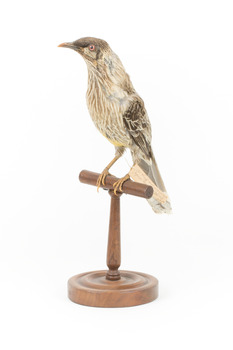Historical information
The red wattlebird is a passerine bird native to southern Australia. Measuring 33–37 cm (13–14.5 inches) in length, it ranks as the second-largest species among Australian honeyeaters. The species was first described by John White in 1790, and three subspecies are currently recognised. The red wattlebird is found across southeast Queensland, New South Wales, Victoria, South Australia, and southwest Western Australia, inhabiting open forests, woodlands, and urban gardens or parks. Known for its loud and conspicuous presence, the red wattlebird primarily forages in trees, although it occasionally searches for food on the ground. As one of the world's largest nectar-feeding birds, it consumes nectar from a wide variety of flowering plants, supplementing its diet with insects. Territorial and sometimes aggressive, it defends rich nectar sources from other bird species. Breeding occurs throughout its range, with the species constructing cup-shaped nests in trees and raising one or two broods annually. Despite localized declines due to habitat loss, the red wattlebird is listed as Least Concern on the IUCN Red List.
This specimen was falsely identified as a yellow wattlebird in original catalogue records and is part of a collection of almost 200 animal specimens that were originally acquired as skins from various institutions across Australia, including the Australian Museum in Sydney and the National Museum of Victoria (known as Museums Victoria since 1983), as well as individuals such as amateur anthropologist Reynell Eveleigh Johns between 1860-1880. These skins were then mounted by members of the Burke Museum Committee and put-on display in the formal space of the Museum’s original exhibition hall where they continue to be on display. This display of taxidermy mounts initially served to instruct visitors to the Burke Museum of the natural world around them, today it serves as an insight into the collecting habits of the 19th century.
Significance
This specimen is part of a significant and rare taxidermy mount collection in the Burke Museum. This collection is scientifically and culturally important for reminding us of how science continues to shape our understanding of the modern world. They demonstrate a capacity to hold evidence of how Australia’s fauna history existed in the past and are potentially important for future environmental research.
This collection continues to be on display in the Museum and has become a key part to interpreting the collecting habits of the 19th century.
Physical description
The red wattlebird has predominantly grey-brown plumage, featuring red eyes, pale pinkish-red wattles on each side of the neck, white streaking on the chest, and a prominent yellow patch on the lower belly.
Inscriptions & markings
Swing-tag:
58a. / Wattled - Honeyeater / See catalogue page 18


























